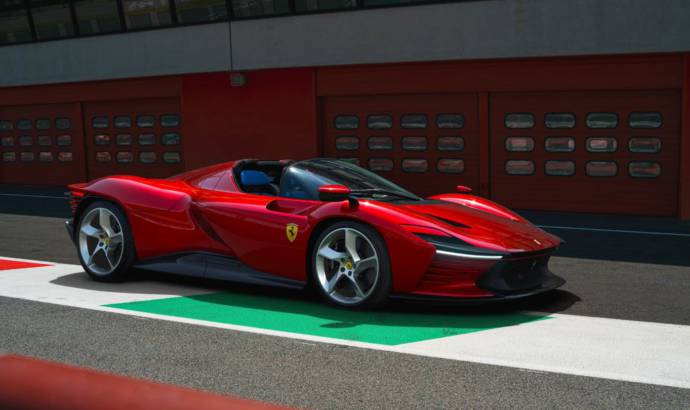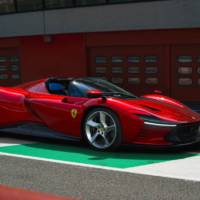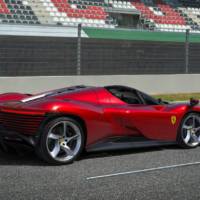From time to time, Ferrari is unveiling a unique project, created for one client that pays enogh for the effort. The most recent addition to thi exclusive range of cars was unveiled the recent days. The Daytona SP3 sports a naturally-aspirated V12, mid-rear-mounted in typical racing car style. Undisputedly the most iconic of all Maranello’s engines, this power unit delivers 840 cv – making it the most powerful engine ever built by Ferrari – along with 697 Nm of torque and maximum revs of 9500 rpm.
Although inspired by the stylistic language of 1960s racing cars, the Daytona SP3 is clothed in very undeniably original, modern forms. Its sculptural power celebrates and interprets the sensual volumes of sports prototypes to wholly contemporary effect. It goes without saying that a design this ambitious demanded a meticulously planned and executed strategy from Chief Design Officer Flavio Manzoni and his Styling Centre team.
The clean double-crested front wings are a nod to the sculptural elegance of past Ferrari sports prototypes of the likes of the 512 S, 712 Can-Am and 312 P. The shape of the wheelarches efficiently connotes the geometry of the flanks. At the front, they are structural and create a powerful link between wheel and well by not completely following the circular profile of the tyre. The rear flank swells out from the sylph-like waist giving rise to a powerful rear muscle that wraps around the front of the wheels, then tapers back towards the tail, lending a powerful dynamism to the three-quarter view.
Another key element is the butterfly doors, which have an air box integrated into them to channel air to the side-mounted radiators; the resulting sculptural forms give the doors a pronounced shoulder housing the air intake that is visually linked to the vertical cut of the windscreen. The pronounced surface of the doors, whose leading edge forms the rear of the front wheelarch, also helps to manage the airflow emerging from the front wheels. This surface treatment also closely recalls that of cars such as the 512 S which partly inspired the Daytona SP3’s stylistic code.
The rear bodywork highlights the powerful appearance of the wing by the repetition of the twin-crest theme and the aerodynamic vent that boosts its three-dimensional volume. The compact, tapered cockpit combines with the wings to create a powerful tail with a central backbone element inspired by the 330 P4. The naturally-aspirated V12, the living beating heart of the new Ferrari Icona, is revealed in all its glory at the end of this backbone.
Even the Daytona SP3’s cockpit takes its inspiration from historic Ferraris such as the 330 P3/4, the 312 P and the 350 Can-Am. Starting with an idea of a high-performance chassis, the designers crafted a meticulously refined space that delivers the comfort and sophistication of a modern Grand Tourer whilst keeping the styling language quite minimalist. It retains the philosophy behind certain styling codes: the dash, for instance, is minimalist and functional yet also entirely contemporary in feel. The typical upholstered cushions that were directly attached to the chassis on sports prototypes have been transformed into modern seats integrated into the body, creating a seamless textural continuity with the surrounding trim.
The seats are integrated into the chassis and thus have the ergonomic wraparound design typical of high-performance cars, but also the kind of meticulous detailing that sets them apart. The textural connection between the seats and the extension of the theme to the adjacent trimmed areas, as well as certain volumetric effects, were possible because they are fixed, while the driver’s adjustments are taken care of by an adjustable pedal box. The clear break between the technical area of the cockpit and the occupant area also allowed the seat volume to be extended all the way to the floor. Even the headrests reference their competition counterparts, but while in the latter they are integrated into single-piece seats, in the Daytona SP3 they are independent. The fixed seat and adjustable pedal box architecture meant they could be anchored to the rear trim, thus also helping to visually lighten the cockpit.
To give the Daytona SP3 the most exhilarating V12 on the market, Ferrari chose the 812 Competizione’s engine as its starting point, but relocated it to the mid-rear position to optimise the intake and exhaust layout as well as fluid-dynamic efficiency. The result is that the F140HC engine is the most powerful internal co mbustion engine ever built by Ferrari and deliver a massive 840 cv with the typical exhilarating power and sound of a Prancing Horse V12.
The engine has a 65° vee between its cylinder banks and retains the 6.5-litre capacity of its predecessor, the F140HB, sported by the 812 Competizione from which it inherits its upgrades. All the developments enhance the performance of a powertrain that sets the new benchmark for its category thanks to its astonishing soundtrack – obtained through targeted work on both the intake and exhaust lines – and the 7-speed gearbox, which is now even faster and more satisfying than ever thanks to the development of specific strategies.
Maximum revs of 9,500 rpm and a torque curve that rises rapidly all the way up to maximum revs gives occupants the feeling of boundless power and acceleration. Particular attention was lavished on reducing the engine’s weight and inertia by adopting titanium con rods, which are 40% lighter than steel, and the use of a different material for the pistons. The new piston pins have a Diamond Like Carbon treatment (DLC), which reduces the coefficient of friction to improve performance and fuel consumption. The crankshaft has been rebalanced and is now also now 3% lighter.





